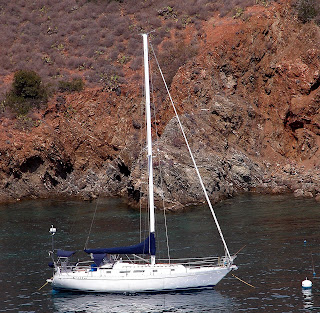It seems like I've spent the past 40+ years dreaming and comparing boats with the idea of one day breaking the shackles of everyday life and go sailing. The iterations of what I thought might be my ideal boat changed over time, reflecting my biases as I gained more experience on a variety of boats, both chartering and racing. Of course when time came to actually purchase a boat, finances also played a significant role in my ultimate decision.
I find it interesting to know the criteria and process people use to decide what their chosen boat will be. I can actually remember in the late 1950's, when I thought Bear boats were some of the prettiest sailboats on San Francisco bay (I still think they are!). I'd dream about being able to sail on one, rather than the power boat my father built. In retrospect, while there are few things as lovely as a wooden boat, I'd rather be sailing than sanding and varnishing (or painting).
Before I had much sailing experience, I went through a period where the more 'salty' designs appealed to me. The Hudson Force 50's, the Tahitian ketches, the Downeasters, the Hans Christians all held a special aesthetic appeal for me. However, due to either size constraints or performance limitations or a combination, they fell further down my wish list. After spending more time racing in modern racing designs of the time ('70's, '80's and '90's), my ideas of what might represent more desirable traits in a sailboat changed once again.
I had exhausted my desire for bright work growing up on my Dad's boat. With a modicum of racing under my belt, performance under sail was higher on my list of wants in a boat. Quality of construction, along with affordability were just as important. Knowing that I would be sailing with my wife as crew and that we weren't going to sell everything to finance our adventure, each contributed to setting size constraints. I had to feel comfortable handling the boat alone under the worst possible conditions, whether sailing or anchoring, without undue reliance on overly complex mechanical aids to allow me to do so. Pushing against this need for manageability and simplicity was the desire for comfort and sea-worthyness.
It was evident that fiberglass construction won out over wood. With regard to size, something in the 34 to 44 foot range would likely allow for being able to safely manage alone, while affording some live aboard comfort and safety. I hold highly the comfort and tracking ability of a displacement full keeled boat in a seaway, but abhor the relative lack of response and maneuverability in light air and tight spaces. If I had my "druthers", I'd likely opt for a skeg hung rudder. They would seem to be a bit more secure than a spade rudder and would likely track a bit straighter, too. However, I don't view this detail as a deal buster. Boats that made it to our final selection criteria included Tartan 34, Tartan 37, Ericson 38, Cal 39, Islander 40 and Peterson 44. Examining examples of each of these in the used boat market, we narrowed it down to a Cal 39 by Lapworth and another Cal 39 by Hunt. We ended up with the 1982 Cal 39 MRK III by William Lapworth.
It was well kept and upgraded. It was newly re-powered with a 3 cylinder Yanmar diesel (400 hours). It was in need of some cosmetic work, but nothing extreme given the boats vintage. The hull and through-hulls were all sound; the deck to hull joint showed no signs of leakage; and there were only two small voids in the fiberglass on the cabin top. All else were judged 'good' to 'very good' on the survey.
While the Cal 39 is not a recognized 'world cruiser', this compromise makes for a comfortable, easily handled coastal cruiser with good sailing characteristics. It is capable of sailing in light winds and making good way to weather. Sailing off-shore is not beyond the capabilities of this boat and several have made credible off-shore voyages with at least one around the world passage. It met a large number of our criteria for a suitable sailing vessel for our purposes and we haven't been disappointed.

